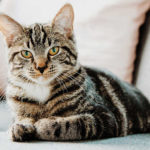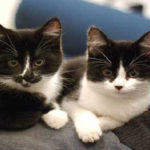When it comes to adopting a cat, we often focus on their breed and health, neglecting another crucial aspect: their lifespan. Today, let’s explore how long cats live and the easiest way to calculate their age!
1 What is the Lifespan of a Cat?
The record for the oldest cat is 32 years, an impressive lifespan for our feline friends. However, the average lifespan of cats is estimated to be 15-16 years. Throughout their lives, cats go through several distinct stages:
 What is the Lifespan of a Cat?
What is the Lifespan of a Cat?
5-12 days old: Newborn kittens have their eyes closed and are adjusting to their new environment.
8-12 days: Kittens’ eyes start to open.
16-20 days: They begin to crawl and explore their surroundings.
3-4 weeks old: Kittens start teething and can chew on harder objects.
6 weeks old: Kittens should be weaned from their mother’s milk and introduced to solid food.
8 weeks old: Cats start to develop independence and may begin to distance themselves from their mother.
6 months old: Their adult teeth come in, replacing their baby teeth.
7-9 months old: Cats reach sexual maturity and may start seeking mates. Female cats will experience their first heat cycle and can become pregnant.
6-8 years: The cat’s activity levels decrease, and their teeth may start to yellow.
Over 12 years: The cat’s health declines, and they eat less due to a weaker digestive system.
15-16 years: The cat is in the twilight of its life and is more susceptible to diseases affecting the heart, liver, and lungs. Their physical condition is frail.
Additional Tip: To prevent diseases in cats, it is recommended to vaccinate them for parvovirus, hepatitis, and enteritis.
2 Average Lifespan of Different Cat Breeds
|
Cat Breed
|
Average Lifespan
|
|
Burmese Cat
|
18 – 25 years
|
|
Ragdoll Cat
|
15 – 25 years
|
|
Balinese Cat
|
18 – 22 years
|
|
Persian Cat
|
15 – 20 years
|
|
Sphynx Cat
|
15 – 20 years
|
|
Bombay Cat
|
20 years
|
|
Russian Cat
|
10 – 20 years
|
|
Oriental Shorthair Cat
|
15 years
|
|
Siamese Cat
|
15 – 20 years
|
|
Manx Cat
|
15 years
|
 Average Lifespan of Different Cat Breeds
Average Lifespan of Different Cat Breeds
3 How to Calculate a Cat’s Age
The simplest way to calculate a cat’s age is by using a human age equivalent. Here’s a conversion chart:
|
Cat’s Age in Years
|
Human Age Equivalent
|
|
1 – 2 weeks
|
3 months
|
|
3 – 4 weeks
|
6 months
|
|
2 months
|
3 years
|
|
4 months
|
6 years
|
|
6 months
|
14 years
|
|
1 year
|
18 years
|
|
2 years
|
22 years
|
|
3 years
|
26 years
|
|
4 years
|
30 years
|
|
5 years
|
36 years
|
|
6 years
|
40 years
|
|
7 years
|
44 years
|
|
8 years
|
48 years
|
|
9 years
|
52 years
|
|
10 years
|
56 years
|
|
11 years
|
60 years
|
|
12 years
|
64 years
|
|
13 years
|
68 years
|
|
14 years
|
72 years
|
|
15 years
|
76 years
|
|
16 years
|
80 years
|
|
17 years
|
|
|
18 years
|
88 years
|
|
19 years
|
92 years
|
|
20 years
|
96 years
|
 How to Calculate a Cat’s Age
How to Calculate a Cat’s Age
4 How to Extend a Cat’s Lifespan
To help your feline friend live a longer and healthier life, consider the following tips to reduce health issues:
-
Schedule regular health check-ups for your cat.
-
Keep your cat indoors to minimize the risk of accidents and infections.
-
Create a balanced diet for your cat and monitor their eating habits.
-
Keep track of your cat’s weight to ensure they are not under or overweight.
-
Play with your cat daily to keep them active and engaged.
-
Brush their fur regularly to detect any swelling, lumps, or skin infections early on.
-
Clean their litter box daily to maintain hygiene.
-
Provide your cat with clean drinking water.
-
Observe your cat’s behavior for any unusual changes.
-
Use a GPS tracker on your cat’s collar to easily locate them if they wander off.
 How to Extend a Cat’s Lifespan
How to Extend a Cat’s Lifespan
Now you know the average lifespan of cats and how to calculate their age. Use this knowledge to provide the best care for your furry friend throughout their life stages!
Is Cat Hair Loss Normal? Understanding and Treating Your Cat’s Hair Loss
“Pet owners often worry when they see their beloved feline friends shedding hair. It’s a common concern, and many wonder about the cause. So, today, we will shed some light on this very topic and explain why cats shed their fur! Stay tuned as we unravel the mystery behind your cat’s shedding habits.”
The Scottish Fold: A Comprehensive Guide to its Origins, Characteristics, Care and Pricing
The Scottish Fold, or simply the ‘Fold’, is an adorable breed of cat with a unique biological trait; its ears fold forward and downward, giving it a distinctive and charming appearance. This breed originated in Scotland and has since captured the hearts of cat lovers worldwide. With their sweet faces and affectionate nature, it’s no wonder that people are eager to learn more about their history, care, and availability. This introduction aims to provide a glimpse into the world of the Scottish Fold, offering insight into their origins, the specific care they require, and the process of welcoming one of these captivating cats into your home.





































